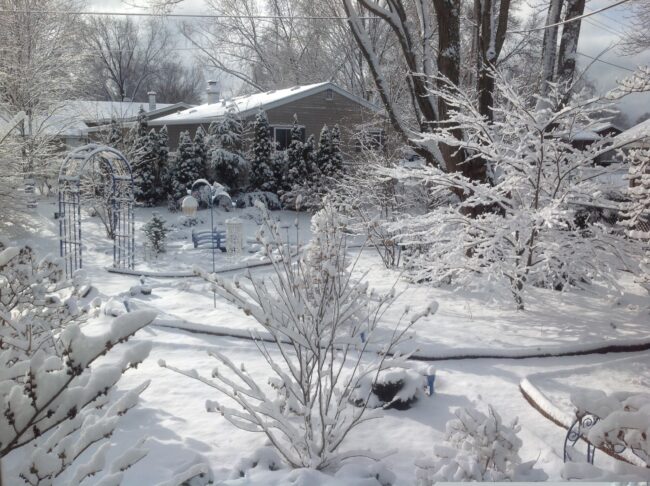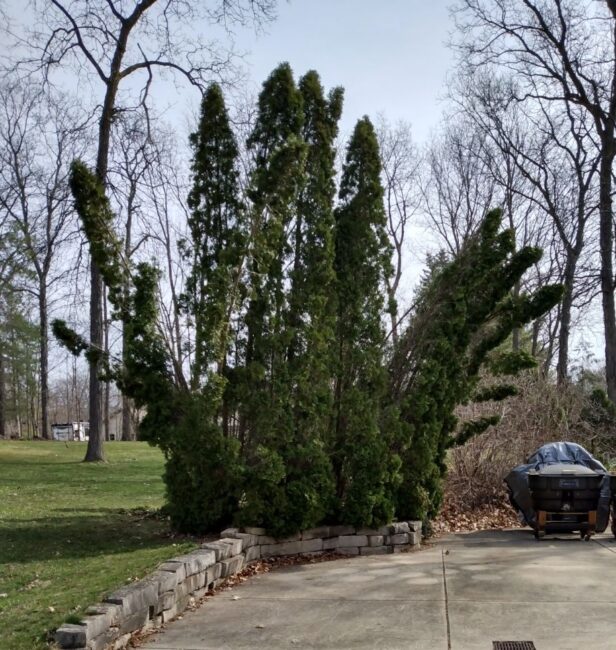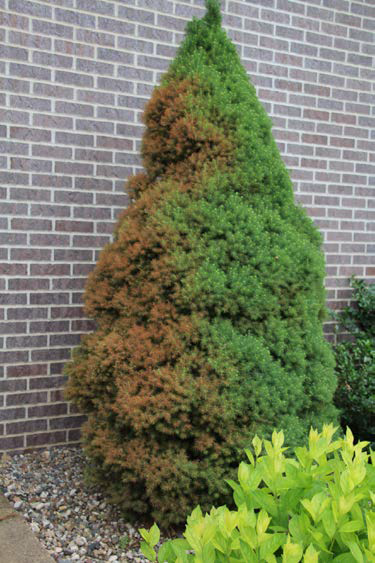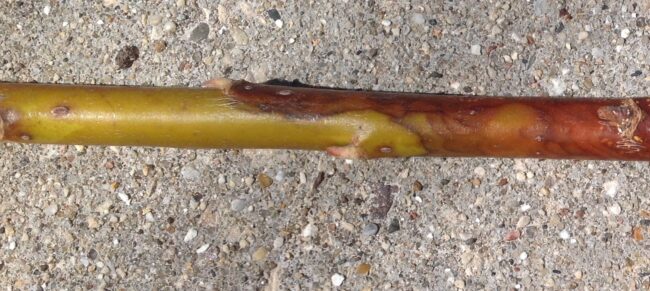If you are feeling a bit of weather whiplash, you are not alone. Some plants have leafed out or are blooming a few weeks earlier than usual due to the record-breaking warm weather in February and early March. Now, Mother Nature as she often does, is doing a bit of a course correction and we are back to more seasonal winter weather – and in fact, lower than normal temperatures.

The recent heavy snowfalls have exacerbated issues I’ve been hearing about from earlier wet snows this past winter. The most frequent problem I am contacted about is splits in arborvitae.

While they may straighten on their own, this late in the season it is doubtful that there will be a complete recovery without intervention on your part.
Ideally, you’d want to ‘tie’ the arborvitae up in late fall to prevent this from happening over winter. However, I recognize that some arborvitae, like these, are too tall to easily accomplish that. Tying them up may help the trees to straighten over the growing season. You need a soft, stretchy material for ties/ wires or rubber hose may girdle the branches or trunks. If the trees are not too weighty, you could use old pantyhose for tying. Otherwise, you can order 4-inch-wide burlap on a roll. You may need to use fence posts or electrical to fasten ties to if the trunks are large. With our winter weather becoming more unpredictable and heavy snow or rain a more common event, it is a good idea to invest in some ties to use going forward.
Another frequently asked question is ‘What will happen to the plants that are blooming or leafing out ahead of schedule’? There are a lot of factors that contribute to whether or not flowers, flower buds, leaf buds or leaves, and roots or plant vascular tissue experience cold damage. For woody plants, last year’s weather can affect the likelihood of cold damage. Drought-stressed plants are more susceptible to winter injury. Watering your woody plants, especially evergreens, into late fall can help prevent winter burn or vascular damage so plants go into winter well hydrated.

Winter burn is common on evergreens grown in unprotected locations in sun or next to a building in a lot of sun (especially the south and west sides of homes). On sunny winter days, evergreen foliage exposed to sun and warm temperatures can begin to transpire (i.e., lose water via pores in the foliage). Since the ground is frozen, roots are unable to take up water and replace the water that lost from the foliage, and as a result, this foliage desiccates and browns. Strong winter winds can lead to additional foliar water loss, also making winter burn more severe. Colder than normal temperatures, especially after a long warm spell can cause winter burn on evergreens as well. Evergreens just planted in fall or within the last couple of years with root systems that are not fully established are especially vulnerable. Winter burn symptoms often become apparent in spring, when snow melts and temperatures rise.
Damage can occur with on branches and trunks of deciduous woody plants as well, especially if we have a long, warm fall, then an extreme cold snap. When this happens, plants have often not gone into dormancy properly. Lack of snow cover after a warm fall and then a severe cold snap can cause root damage as well. Vascular damage (damage to the plant’s water and food conducting tissues located right below the bark) is not always immediately apparent. Sometimes you can see discolored or wrinkled bark, especially on thin-barked or younger trees and branches. If you ‘scratch’ such bark with a fingernail and the tissue underneath is brown, it is typically dead and won’t conduct water. If it is green, there is still a chance it may recover. But sometimes, the discoloration does not appear and the branch simply doesn’t leaf out. Or, the branch may break bud and/or start to leaf out, but then the buds/leaves shrivel and die since the vascular system can’t supply them with water.

Woody plants are usually fully dormant in December and January, unless temperatures have been too warm. While fully dormant, they won’t break bud, even with warmer weather, because the buds haven’t received enough chilling hours for them to break dormancy. Chilling hours on average are about 6-8 weeks below 40°F, but some plants need even colder temperatures for longer periods. During March and April however, most woody plants enter ‘quiescence’, a sort of resting state, where various plant hormones cause the plants to start to de-acclimate from dormancy, preparing for warmer weather. This can make cold damage more likely if below freezing temperatures occur.
Topography matters too – since cold air sinks, gardens in low areas, often called frost pockets, may experience more damage than gardens in more upland areas. Urban areas surrounded by buildings and asphalt that give off heat at night can also protect plants. However, heat off those same buildings in daytime may have pushed plants to grow more even earlier, so they may be farther along and more likely to experience damage than plants in cooler more rural areas.
For this spring, woody plants, as long as the leaf or flower buds are not too far open, should be fine (barring drought issues) since the buds are protected by bud scales that cover them. On the other hand, if tree buds have opened or leaves have started to expand, cold injury can occur when temperatures drop sharply at sunset causing foliage that has warmed during the day to rapidly cool and freeze, especially if temperatures drop below freezing.
A light frost, 32°F to about 29°F, won’t damage the leaf buds of most perennial and woody plants and perhaps not even if flower buds that have started to show color. But once flowers open, they are a lot more vulnerable. When temperatures drop into the mid-20 degree range or lower, then it is likely that some damage to fully open flowers and leaves will occur. Other factors also play into it. For example, still, windless nights have lower temperatures, especially under clear skies. The duration of the low temperature, how low it goes and the genetics of the particular plant also factor in. As an example of genetics, the Lenten rose (hellebore), and corneliancherry dogwood which typically bloom in March are more resilient than plants that typically bloom later in April, but are blooming or leafing out now due to the early warm weather.
As a protective measure, if your plants are in bloom or leafing out and temperatures in the 20’s are predicted, and you can cover them with a sheet, this may help as night temperatures dip into the low double digits.
We will really just have to wait and see.




